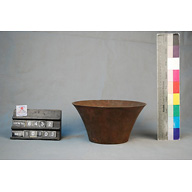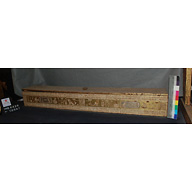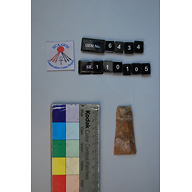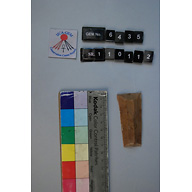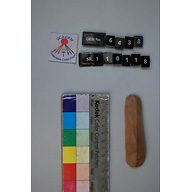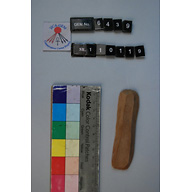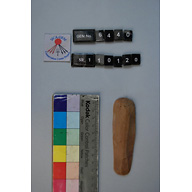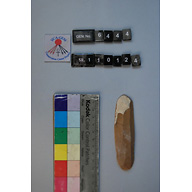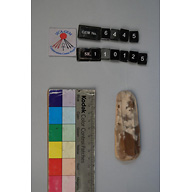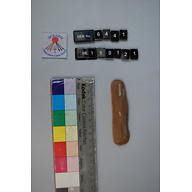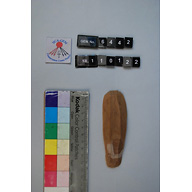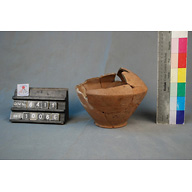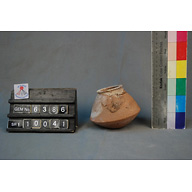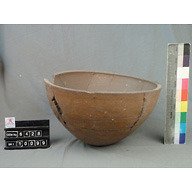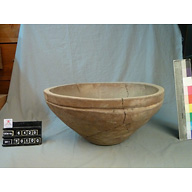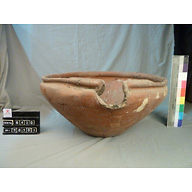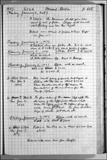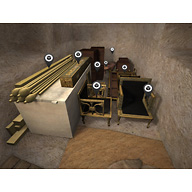Eastern Cemetery: Site: Giza; View: G 7000 X
-
- Tomb Owner
- Hetepheres I (G 7000 X)
-
- Attested
- Ankhnesmeryre
- Huni
- Kawab (G 7110-7120)
- Khufu
- Meresankh III (G 7530-7540)
- Snefru
-
- Excavator
- George Andrew Reisner, American, 1867–1942
-
- PorterMoss Date
- Khufu
-
- Site Type
- Shafts only (no superstructure)
-
- GEM_6329
-
- GEM_6330
-
- GEM_6319
-
- GEM_6320
-
- GEM_6321
-
- GEM_6322
-
- GEM_6323
-
- GEM_6324
-
- GEM_6325
-
- GEM_6326
-
- GEM_6327
-
- GEM_6328
-
- EMC_JE_72027
-
- GEM_6304
-
- GEM_6301
-
- GEM_6302
-
- GEM_6305
-
- GEM_6306
-
- GEM_6307
-
- GEM_6308
-
- GEM_6309
-
- GEM_6310
-
- GEM_6311
-
- GEM_6312
-
- GEM_6314
-
- GEM_6315
-
- GEM_6316
-
- GEM_6317
-
- GEM_6313
-
- GEM_6318
-
- EMC_JE_72028
-
- EMC_JE_72029
-
Alabaster model jar with handle
- GEM_6341g
-
Alabaster model jar with handle
- GEM_6341h
-
- GEM_6341a
-
- GEM_6341b
-
- GEM_6341c
-
- GEM_6341d
-
- GEM_6341e
-
- GEM_6341f
-
- GEM_6303
-
Arm chair of Hetepheres I (reproduction)
- MFAB_38.957
-
Armchair of Queen Hetepheres I
- GEM_6365
-
Bed canopy of Queen Hetepheres I
- GEM_6372
-
Bed of Hetepheres I (reproduction)
- MFAB_29.1858
-
- GEM_6364
-
Bracelet box of Queen Hetepheres I
- GEM_6424
-
Canopy of Hetepheres I (reproduction)
- MFAB_38.873
-
Carrying chair of Hetepheres I (reproduction)
- MFAB_38.874
-
Carrying chair of Queen Hetepheres I
- GEM_6362
-
- HUMFA_25-3-161
-
- GEM_6432
-
- GEM_6245
-
- GEM_6241
-
- GEM_6258
-
- GEM_6239
-
- GEM_6240
-
- GEM_6447
-
- GEM_6259
-
- GEM_6260
-
- GEM_6295
-
- GEM_6296
-
- GEM_6297
-
- GEM_6341i
-
- EMC_JE_52422
-
- EMC_JE_52423
-
- EMC_JE_52424
-
- EMC_JE_52425
-
- EMC_JE_52426
-
Curtain box of Hetepheres I (reproduction)
- MFAB_39.746
-
Curtain box of Queen Hetepheres I
- GEM_6426
-
- MFAB_47.1708
-
- MFAB_37.2726
-
- MFAB_37.2727
-
- MFAB_47.2067
-
- MFAB_47.2068
-
- GEM_6182
-
- GEM_6183
-
- GEM_6188
-
- GEM_6189
-
- GEM_6190
-
- GEM_6434
-
- GEM_6435
-
- GEM_6436
-
- GEM_6437
-
- GEM_6438
-
- GEM_6439
-
- GEM_6440
-
- GEM_6444
-
- GEM_6445
-
- GEM_6446
-
- GEM_6194
-
- GEM_6195
-
- GEM_6196
-
- GEM_6441
-
- GEM_6442
-
- GEM_6443
-
- GEM_6181
-
- HUMFA_25-2-1190
-
- PMAE_5871.1
-
- PMAE_5871.2
-
- PMAE_5871.3
-
- PMAE_5871.4
-
Fragment of pottery bowl with recurved rim
- MFAB_47.1771
-
Fragment of pottery model dish
- EMC_JE_67655
-
Fragment of pottery model dish
- EMC_JE_67656
-
Fragment of pottery model dish
- EMC_JE_67763
-
Fragment of pottery spouted basin
- PMAE_5870.1
-
- MFAB_47.1772
-
- MFAB_47.1774
-
- PMAE_5872.1
-
- PMAE_5872.2
-
- PMAE_5872.3
-
- PMAE_5872.4
-
- PMAE_5872.5
-
- PMAE_5872.6
-
- PMAE_5872.7
-
- PMAE_5872.8
-
- HUMFA_25-3-162
-
- HUMFA_25-2-1191
-
Fragmentary limestone canopy pole socket
- HUMFA_25-3-237
-
Fragmentary pottery bag-shaped jar
- GEM_6411
-
- EMC_JE_67623
-
- EMC_JE_67625
-
- EMC_JE_67626
-
- EMC_JE_67634
-
- EMC_JE_67635
-
- EMC_JE_67636
-
- EMC_JE_67637
-
Fragmentary pottery bowl with lip spout and handles
- HUMFA_34-4-16
-
Fragmentary pottery bowl with lip spout and handles
- HUMFA_34-4-20
-
Fragmentary pottery bowl with lip spout and handles
- EMC_JE_67699
-
Fragmentary pottery bowl with lip spout and handles
- HUMFA_34-4-24
-
Fragmentary pottery bowl with lip spout and handles
- HUMFA_34-4-26
-
Fragmentary pottery bowl with lip spout and handles
- EMC_JE_67701
-
Fragmentary pottery bowl with lip spout and handles
- HUMFA_34-4-28
-
- EMC_JE_67642
-
- EMC_JE_67643
-
- EMC_JE_67644
-
Fragmentary pottery footed bowl
- HUMFA_34-4-9
-
Fragmentary pottery footed bowl
- GEM_6393
-
Fragmentary pottery footed bowl
- EMC_JE_67628
-
- HUMFA_25-2-1096
-
- EMC_JE_67755
-
- HUMFA_34-4-3
-
- PMAE_5863
-
- EMC_JE_67757
-
- HUMFA_34-4-1b
-
- GEM_6392
-
- HUMFA_34-4-7
-
- PMAE_5868
-
Fragmentary pottery model bowl
- GEM_6399
-
Fragmentary pottery model bowl
- EMC_JE_67681
-
Fragmentary pottery model bowl
- EMC_JE_67680
-
Fragmentary pottery model bowl
- EMC_JE_67682
-
Fragmentary pottery model dish
- EMC_JE_67658
-
- HUMFA_25-3-246
-
- HUMFA_25-3-240
-
- HUMFA_25-3-51
-
Fragments of fluted copper objects
- HUMFA_25-3-260
-
- HUMFA_25-3-311
-
Fragments of pottery and various stones
- HUMFA_25-3-312
-
- MFAB_47.1727
-
- MFAB_47.1775
-
- PMAE_5865
-
- EMC_JE_67647
-
- EMC_JE_67648
-
- EMC_JE_67649
-
- MFAB_47.1724
-
- GEM_6368
-
- GEM_6369
-
- EMC_JE_67752
-
Fragments of pottery model bowl
- EMC_JE_67650
-
Fragments of pottery model bowl
- EMC_JE_67651
-
Fragments of pottery model bowl
- EMC_JE_67669
-
Fragments of pottery model bowl
- EMC_JE_67675
-
Fragments of pottery model dish
- EMC_JE_67653
-
Fragments of pottery model dish
- EMC_JE_67652
-
Fragments of pottery model dish
- EMC_JE_67654
-
Fragments of pottery model dish
- EMC_JE_67657
-
Fragments of pottery spouted basin
- PMAE_5870
-
- MFAB_47.1773
-
- PMAE_5872
-
Fragments of various materials
- EMC_TR_18.4.47.5
-
- HUMFA_25-3-50
-
- GEM_6298
-
- GEM_6299
-
- GEM_6300
-
- GEM_6464
-
- GEM_6231
-
- GEM_6232
-
- GEM_6237
-
- GEM_6238
-
- GEM_6233
-
- GEM_6425
-
Headrest of Hetepheres I (reproduction)
- MFAB_29.1859
-
Jewelry: butterfly inlays from silver bracelet
- MFAB_47.1701
-
- EMC_JE_72026
-
- HUMFA_25-3-232
-
- HUMFA_25-3-233
-
- HUMFA_25-3-234
-
- HUMFA_25-3-235
-
- HUMFA_25-3-236
-
- HUMFA_25-3-238
-
- HUMFA_25-3-244
-
- GEM_6261
-
- HUMFA_25-3-239
-
- HUMFA_25-3-243
-
- HUMFA_25-3-245
-
- MFAB_37.2653
-
- MFAB_37.2654
-
- MFAB_37.2662
-
- MFAB_37.2663
-
- MFAB_37.2669
-
- MFAB_37.2671
-
- MFAB_37.2676
-
- MFAB_37.2647
-
- MFAB_37.2649
-
- MFAB_47.1729
-
- MFAB_47.1730
-
- MFAB_47.1731
-
- MFAB_47.1776
-
- MFAB_47.1777
-
- MFAB_47.1778
-
- MFAB_47.1779
-
- MFAB_47.1780
-
- MFAB_47.1781
-
- MFAB_47.1782
-
- MFAB_47.1804
-
- MFAB_47.2101
-
- GEM_6386
-
- GEM_6387
-
- EMC_JE_67712
-
- EMC_JE_67713
-
- EMC_JE_67715
-
- EMC_JE_67718
-
- EMC_JE_67719
-
- EMC_JE_67720
-
- EMC_JE_67721
-
- EMC_JE_67722
-
- EMC_JE_67723
-
- EMC_JE_67724
-
- EMC_JE_67725
-
- EMC_JE_67726
-
- EMC_JE_67727
-
- EMC_JE_67728
-
- GEM_6431
-
- HUMFA_34-4-30
-
- GEM_6408
-
- HUMFA_34-4-29
-
- EMC_JE_67694
-
- GEM_6407
-
- HUMFA_34-4-64
-
- GEM_6406
-
- EMC_JE_67695
-
- PMAE_5866
-
- HUMFA_34-4-68
-
- GEM_6400
-
- MFAB_37.2690
-
- MFAB_37.2648
-
- MFAB_47.1725
-
- MFAB_47.1728
-
- GEM_6356
-
- GEM_6405
-
- GEM_6428
-
- GEM_6429
-
- GEM_6430
-
Pottery bowl with lip spout and handles
- HUMFA_34-4-15
-
Pottery bowl with lip spout and handles
- HUMFA_34-4-19
-
Pottery bowl with lip spout and handles
- HUMFA_34-4-22
-
- GEM_6384
-
Pottery bowl with recurved rim and tubular spout
- EMC_JE_67709
-
Pottery bowl with recurved rim and tubular spout
- HUMFA_34-4-34
-
Pottery bowl with recurved rim and tubular spout
- HUMFA_34-4-35
-
Pottery bowl with recurved rim and tubular spout
- HUMFA_34-4-36
-
Pottery bowl with recurved rim and tubular spout
- HUMFA_34-4-37
-
Pottery bowl with recurved rim and tubular spout
- EMC_JE_67707
-
Pottery bowl with recurved rim and tubular spout
- HUMFA_34-4-40
-
Pottery bowl with recurved rim and tubular spout
- HUMFA_34-4-41
-
Pottery bowl with recurved rim and tubular spout
- HUMFA_34-4-94
-
Pottery bowl with tubular spout
- EMC_JE_67710
-
Pottery cover with ledge handles
- EMC_JE_67645
-
Pottery cover with ledge handles
- MFAB_37.2709
-
Pottery cover with loop handle
- GEM_6395
-
Pottery cover with loop handle
- HUMFA_34-4-43
-
Pottery cover with loop handle
- HUMFA_34-4-44
-
Pottery cover with loop handle
- GEM_6396
-
Pottery cover with loop handle
- HUMFA_34-4-47
-
Pottery cover with loop handle
- HUMFA_34-4-48
-
Pottery cover with loop handle
- EMC_JE_67641
-
Pottery cover with loop handle
- HUMFA_34-4-50
-
Pottery cover with loop handle
- GEM_6427
-
Pottery cover with loop handle
- HUMFA_34-4-52
-
- GEM_6402
-
- HUMFA_34-4-70
-
- GEM_6403
-
- GEM_6381
-
- GEM_6379
-
- HUMFA_34-4-77
-
- PMAE_5864
-
- HUMFA_34-4-79
-
- GEM_6380
-
- HUMFA_34-4-10
-
- GEM_6394
-
- HUMFA_34-4-13
-
- HUMFA_25-2-1095
-
- GEM_6370
-
- EMC_JE_67676
-
- EMC_JE_67679
-
- HUMFA_34-4-84
-
- HUMFA_34-4-85
-
- MFAB_37.2700
-
- MFAB_37.2666
-
- MFAB_37.2667
-
- MFAB_37.2673
-
- MFAB_37.2675
-
- MFAB_47.1735
-
- MFAB_47.1736
-
- MFAB_47.1737
-
- MFAB_47.1738
-
- MFAB_47.1739
-
- GEM_6358
-
- GEM_6359
-
- GEM_6360
-
- GEM_6361
-
- EMC_JE_67665
-
- EMC_JE_67666
-
- EMC_JE_67667
-
- EMC_JE_67668
-
- EMC_JE_67670
-
- EMC_JE_67674
-
- HUMFA_34-4-81
-
- HUMFA_34-4-86
-
- MFAB_47.1741
-
- GEM_6397
-
- GEM_6398
-
- EMC_JE_67664
-
- EMC_JE_67659
-
- EMC_JE_67662
-
- EMC_JE_67663
-
- GEM_6388
-
- GEM_6367
-
- EMC_JE_67731
-
- HUMFA_34-3-9
-
- EMC_JE_67735
-
- GEM_6366
-
- EMC_JE_67734
-
- HUMFA_34-3-13
-
- EMC_JE_67742
-
- HUMFA_34-3-2
-
- HUMFA_34-3-3
-
- HUMFA_34-3-4
-
- EMC_JE_67743
-
- HUMFA_34-3-14
-
- EMC_JE_67729
-
- HUMFA_34-3-16
-
- HUMFA_34-3-17
-
- HUMFA_34-3-18
-
- EMC_JE_67748
-
- HUMFA_34-3-20
-
- HUMFA_34-3-21
-
- HUMFA_34-3-22
-
- EMC_JE_67749
-
- EMC_JE_67746
-
- HUMFA_34-3-25
-
- HUMFA_34-3-26
-
- HUMFA_34-3-27
-
- GEM_6390
-
- GEM_6391
-
- HUMFA_34-3-30
-
- EMC_JE_67732
-
- EMC_JE_67750
-
- HUMFA_34-3-33
-
- HUMFA_34-3-34
-
- EMC_JE_67736
-
- HUMFA_34-3-36
-
- EMC_JE_67738
-
- HUMFA_34-3-38
-
- HUMFA_34-3-39
-
- EMC_JE_67739
-
- EMC_JE_67741
-
- HUMFA_34-3-42
-
- HUMFA_34-3-43
-
- HUMFA_34-3-44
-
- HUMFA_34-3-45
-
- GEM_6389
-
- PMAE_5867
-
- HUMFA_34-3-48
-
- HUMFA_34-3-49
-
- HUMFA_34-3-50
-
- EMC_JE_67737
-
- HUMFA_34-3-52
-
- EMC_JE_67744
-
- MFAB_37.2733
-
- MFAB_47.1732
-
- MFAB_47.1733
-
- MFAB_47.2098
-
- HUMFA_34-4-72
-
- HUMFA_34-4-73
-
- GEM_6378
-
- EMC_JE_67683
-
- HUMFA_34-4-88
-
- HUMFA_34-4-90
-
- GEM_6401
-
- MFAB_47.1726
-
- MFAB_47.2100
-
- HUMFA_34-4-53
-
- HUMFA_34-4-54
-
- GEM_6404
-
- HUMFA_34-4-56
-
- EMC_JE_67761
-
- EMC_JE_67762
-
- HUMFA_34-4-59
-
- EMC_JE_67760
-
- GEM_6371
-
- MFAB_37.2737
-
Silver bracelet with butterfly inlays
- EMC_JE_53267
-
Silver bracelet with butterfly inlays
- EMC_JE_53268
-
Silver bracelet with butterfly inlays
- EMC_JE_53271
-
Silver bracelet with butterfly inlays
- EMC_JE_53274
-
Silver bracelet with butterfly inlays
- EMC_JE_53277
-
Silver bracelet with butterfly inlays
- EMC_JE_53280
-
Silver bracelet with butterfly inlays
- EMC_JE_53281
-
Silver bracelet with butterfly inlays
- EMC_JE_53269
-
Silver bracelet with butterfly inlays
- EMC_JE_53270
-
Silver bracelet with butterfly inlays
- EMC_JE_53272
-
Silver bracelet with butterfly inlays
- EMC_JE_53273
-
Silver bracelet with butterfly inlays
- EMC_JE_53275
-
Silver bracelet with butterfly inlays
- EMC_JE_53276
-
Silver bracelet with butterfly inlays
- EMC_JE_53278
-
Silver bracelet with butterfly inlays
- EMC_JE_53279
-
Silver bracelet with butterfly inlays
- EMC_JE_53266
-
- MFAB_47.1740
-
- HUMFA_25-3-242
-
- HUMFA_25-3-259
-
- HUMFA_25-3-258
-
- GEM_6341j
-
- Diary page dates 02/19/1925
-
- Diary page dates 02/19/1925; 02/20/1925
-
- Diary page dates 02/20/1925
-
- Diary page dates 02/21/1925
-
- Diary page dates 02/21/1925; 02/22/1925
-
- Diary page dates 02/22/1925
-
- Diary page dates 02/22/1925
-
- Diary page dates 02/22/1925
-
- Diary page dates 02/22/1925; 02/23/1925
-
- Diary page dates 02/23/1925
-
- Diary page dates 02/23/1925; 02/24/1925
-
- Diary page dates 02/25/1925
-
- Diary page dates 02/25/1925
-
- Diary page dates 02/26/1925
-
- Diary page dates 02/26/1925; 02/27/1925
-
- Diary page dates 02/27/1925
-
- Diary page dates 02/27/1925
-
- Diary page dates 02/27/1925
-
- Diary page dates 02/28/1925
-
- Diary page dates 02/28/1925
-
- Diary page dates 03/01/1925
-
- Diary page dates 03/01/1925
-
- Diary page dates 03/02/1925
-
- Diary page dates 03/02/1925
-
- Diary page dates 03/02/1925; 03/03/1925; 03/04/1925
-
- Diary page dates 03/04/1925
-
- Diary page dates 03/05/1925
-
- Diary page dates 03/05/1925; 03/06/1925
-
- Diary page dates 03/06/1925
-
- Diary page dates 03/06/1925; 03/07/1925
-
- Diary page dates 03/07/1925
-
- Diary page dates 03/07/1925; 03/08/1925
-
- Diary page dates 03/08/1925
-
- Diary page dates 03/08/1925; 03/09/1925
-
- Diary page dates 03/09/1925
-
- Diary page dates 03/09/1925; 03/10/1925
-
- Diary page dates 03/10/1925; 03/11/1925; 03/12/1925
-
- Diary page dates 03/13/1925
-
- Diary page dates 03/13/1925; 03/14/1925
-
- Diary page dates 03/14/1925; 03/15/1925; 03/16/1925
-
- Diary page dates 03/16/1925; 03/17/1925; 03/18/1925
-
- Diary page dates 03/18/1925; 03/29/1925; 03/20/1925; 03/21/1925
-
- Diary page dates 03/23/1925; 03/24/1925; 03/25/1925
-
- Diary page dates 03/28/1925; 03/29/1925
-
- Diary page dates 04/02/1925
-
- Diary page dates 04/02/1925
-
- Diary page dates 04/02/1925
-
- Diary page dates 04/03/1925; 04/04/1925; 04/05/1925
-
- Diary page dates 04/07/1925
-
- Diary page dates 04/07/1925
-
- Diary page dates 04/07/1925
-
- Diary page dates 04/07/1925
-
- Diary page dates 04/07/1925
-
- Diary page dates 11/17/1925
-
- Diary page dates 11/25/1925
-
- Diary page dates 12/08/1925; 12/09/1925
-
- Diary page dates 01/20/1926; 01/21/1926
-
- Diary page dates 01/21/1926
-
- Diary page dates 01/21/1926
-
- Diary page dates 01/21/1926; 01/22/1926
-
- Diary page dates 01/22/1926
-
- Diary page dates 01/23/1926
-
- Diary page dates 01/24/1926
-
- Diary page dates 01/24/1926; 01/25/1926
-
- Diary page dates 01/25/1926; 01/26/1926; 01/27/1926
-
- Diary page dates 01/27/1926
-
- Diary page dates 01/27/1926; 01/28/1926
-
- Diary page dates 01/28/1926
-
- Diary page dates 01/29/1926
-
- Diary page dates 01/29/1926
-
- Diary page dates 01/30/1926
-
- Diary page dates 01/31/1926; 02/01/1926
-
- Diary page dates 02/02/1926; 02/03/1926
-
- Diary page dates 02/04/1926
-
- Diary page dates 02/04/1926
-
- Diary page dates 02/04/1926
-
- Diary page dates 02/04/1926; 02/05/1926
-
- Diary page dates 02/05/1926
-
- Diary page dates 02/06/1926
-
- Diary page dates 02/06/1926
-
- Diary page dates 02/06/1926
-
- Diary page dates 02/07/1926
-
- Diary page dates 02/07/1926
-
- Diary page dates 02/08/1926
-
- Diary page dates 02/08/1926
-
- Diary page dates 02/10/1926
-
- Diary page dates 02/10/1926; 02/11/1926
-
- Diary page dates 02/11/1926
-
- Diary page dates 02/11/1926; 02/12/1926
-
- Diary page dates 02/12/1926
-
- Diary page dates 02/12/1926
-
- Diary page dates 02/12/1926
-
- Diary page dates 02/12/1926
-
- Diary page dates 02/12/1926; 02/13/1926
-
- Diary page dates 02/14/1926
-
- Diary page dates 02/14/1926; 02/15/1926
-
- Diary page dates 02/16/1926
-
- Diary page dates 02/16/1926
-
- Diary page dates 02/17/1926
-
- Diary page dates 02/17/1926; 02/18/1926
-
- Diary page dates 02/18/1926
-
- Diary page dates 02/19/1926
-
- Diary page dates 02/19/1926; 02/20/1926
-
- Diary page dates 02/20/1926; 02/21/1926
-
- Diary page dates 02/21/1926
-
- Diary page dates 02/21/1926; 02/22/1926
-
- Diary page dates 02/23/1926
-
- Diary page dates 02/24/1926
-
- Diary page dates 02/24/1926
-
- Diary page dates 02/24/1926; 02/25/1926
-
- Diary page dates 02/25/1926
-
- Diary page dates 02/25/1926; 02/26/1926
-
- Diary page dates 02/26/1926; 02/27/1926
-
- Diary page dates 02/27/1926
-
- Diary page dates 02/28/1926
-
- Diary page dates 02/28/1926; 03/01/1926
-
- Diary page dates 03/01/1926; 03/02/1926
-
- Diary page dates 03/02/1926
-
- Diary page dates 03/03/1926
-
- Diary page dates 03/04/1926
-
- Diary page dates 03/04/1926; 03/05/1926
-
- Diary page dates 03/05/1926; 03/06/1926
-
- Diary page dates 03/06/1926; 03/07/1926
-
- Diary page dates 03/07/1926
-
- Diary page dates 03/08/1926
-
- Diary page dates 03/09/1926; 03/10/1926
-
- Diary page dates 03/10/1926
-
- Diary page dates 03/10/1926; 03/11/1926
-
- Diary page dates 03/11/1926
-
- Diary page dates 03/11/1926; 03/12/1926
-
- Diary page dates 03/13/1926
-
- Diary page dates 03/14/1926
-
- Diary page dates 03/15/1926
-
- Diary page dates 03/16/1926
-
- Diary page dates 03/16/1926
-
- Diary page dates 03/17/1926
-
- Diary page dates 03/17/1926
-
- Diary page dates 03/17/1926; 03/18/1926
-
- Diary page dates 03/18/1926; 03/19/1926
-
- Diary page dates 03/19/1926; 03/20/1926
-
- Diary page dates 03/20/1926
-
- Diary page dates 03/20/1926; 03/21/1926
-
- Diary page dates 03/21/1926
-
- Diary page dates 03/21/1926; 03/22/1926
-
- Diary page dates 03/23/1926; 03/24/1926
-
- Diary page dates 03/24/1926
-
- Diary page dates 03/25/1926
-
- Diary page dates 03/25/1926
-
- Diary page dates 03/25/1926; 03/26/1926
-
- Diary page dates 03/26/1926; 03/27/1926
-
- Diary page dates 03/27/1926
-
- Diary page dates 03/28/1926
-
- Diary page dates 03/28/1926; 03/29/1926
-
- Diary page dates 03/29/1926
-
- Diary page dates 03/30/1926
-
- Diary page dates 03/31/1926
-
- Diary page dates 03/31/1926; 04/01/1926
-
- Diary page dates 04/01/1926
-
- Diary page dates 04/01/1926; 04/02/1926
-
- Diary page dates 04/02/1926
-
- Diary page dates 04/03/1926; 04/04/1926
-
- Diary page dates 04/04/1926
-
- Diary page dates 04/04/1926
-
- Diary page dates 04/04/1926; 04/05/1926
-
- Diary page dates 04/05/1926
-
- Diary page dates 04/05/1926; 04/06/1926
-
- Diary page dates 04/06/1926; 04/07/1926
-
- Diary page dates 04/07/1926
-
- Diary page dates 04/07/1926; 04/08/1926
-
- Diary page dates 04/08/1926
-
- Diary page dates 04/09/1926
-
- Diary page dates 04/09/1926; 04/10/1926
-
- Diary page dates 04/10/1926; 04/11/1926
-
- Diary page dates 04/11/1926
-
- Diary page dates 04/11/1926; 04/12/1926
-
- Diary page dates 04/12/1926; 04/13/1926
-
- Diary page dates 04/14/1926
-
- Diary page dates 04/15/1926
-
- Diary page dates 04/15/1926
-
- Diary page dates 04/16/1926
-
- Diary page dates 04/16/1926; 04/17/1926
-
- Diary page dates 04/17/1926
-
- Diary page dates 04/18/1926
-
- Diary page dates 04/18/1926
-
- Diary page dates 04/19/1926
-
- Diary page dates 04/19/1926
-
- Diary page dates 04/20/1926; 04/21/1926
-
- Diary page dates 04/21/1926
-
- Diary page dates 04/22/1926
-
- Diary page dates 04/22/1926
-
- Diary page dates 04/23/1926
-
- Diary page dates 04/23/1926; 04/24/1926
-
- Diary page dates 04/24/1926; 04/25/1926
-
- Diary page dates 04/25/1926
-
- Diary page dates 04/26/1926
-
- Diary page dates 04/26/1926; 04/27/1926; 04/28/1926
-
- Diary page dates 04/28/1926
-
- Diary page dates 04/29/1926
-
- Diary page dates 04/29/1926
-
- Diary page dates 04/30/1926
-
- Diary page dates 04/30/1926
-
- Diary page dates 05/01/1926
-
- Diary page dates 05/02/1926; 05/03/1926
-
- Diary page dates 05/04/1926
-
- Diary page dates 05/06/1926; 05/07/1926
-
- Diary page dates 05/08/1926; 05/09/1926
-
- Diary page dates 05/09/1926
-
- Diary page dates 05/10/1926; 05/11/1926; 05/12/1926
-
- Diary page dates 05/13/1926; 05/14/1926
-
- Diary page dates 05/15/1926; 05/16/1926
-
- Diary page dates 05/17/1926; 05/18/1926; 05/19/1926
-
- Diary page dates 05/20/1926; 05/21/1926
-
- Diary page dates 05/21/1926; 05/22/1926
-
- Diary page dates 05/22/1926; 05/23/1926; 05/24/1926
-
- Diary page dates 05/25/1926; 05/26/1926
-
- Diary page dates 05/27/1926
-
- Diary page dates 05/28/1926
-
- Diary page dates 05/29/1926
-
- Diary page dates 05/31/1926
-
- Diary page dates 05/31/1926; 06/01/1926
-
- Diary page dates 06/02/1926; 06/03/1926
-
- Diary page dates 06/04/1926
-
- Diary page dates 06/04/1926; 06/05/1926
-
- Diary page dates 06/06/1926; 06/07/1926
-
- Diary page dates 06/08/1926; 06/09/1926
-
- Diary page dates 06/10/1926
-
- Diary page dates 06/11/1926; 06/12/1926
-
- Diary page dates 06/12/1926; 06/13/1926; 06/14/1926
-
- Diary page dates 06/14/1926
-
- Diary page dates 06/15/1926; 06/16/1926; 06/17/1926
-
- Diary page dates 06/18/1926
-
- Diary page dates 06/18/1926; 06/19/1926
-
- Diary page dates 06/19/1926
-
- Diary page dates 06/20/1926
-
- Diary page dates 06/20/1926; 06/21/1926
-
- Diary page dates 06/22/1926; 06/23/1926
-
- Diary page dates 06/23/1926
-
- Diary page dates 06/23/1926; 06/24/1926
-
- Diary page dates 06/24/1926
-
- Diary page dates 06/25/1926; 06/26/1926
-
- Diary page dates 06/26/1926; 06/27/1926
-
- Diary page dates 06/27/1926
-
- Diary page dates 06/27/1926; 06/28/1926
-
- Diary page dates 06/28/1926
-
- Diary page dates 06/28/1926
-
- Diary page dates 06/28/1926; 06/29/1926; 06/30/1926
-
- Diary page dates 06/30/1926
-
- Diary page dates 06/30/1926
-
- Diary page dates 07/01/1926
-
- Diary page dates 07/01/1926; 07/02/1926
-
- Diary page dates 07/02/1926
-
- Diary page dates 07/02/1926; 07/03/1926
-
- Diary page dates 07/03/1926
-
- Diary page dates 07/03/1926; 07/04/1926
-
- Diary page dates 07/04/1926
-
- Diary page dates 07/04/1926
-
- Diary page dates 07/04/1926; 07/05/1926
-
- Diary page dates 07/05/1926
-
- Diary page dates 07/05/1926; 07/06/1926
-
- Diary page dates 07/07/1926
-
- Diary page dates 07/07/1926
-
- Diary page dates 07/07/1926; 07/08/1926
-
- Diary page dates 07/08/1926
-
- Diary page dates 07/09/1926
-
- Diary page dates 07/09/1926
-
- Diary page dates 07/10/1926
-
- Diary page dates 07/10/1926; 07/11/1926
-
- Diary page dates 07/11/1926; 07/12/1926
-
- Diary page dates 07/12/1926; 07/13/1926; 07/14/1926
-
- Diary page dates 07/14/1926; 07/15/1926
-
- Diary page dates 07/15/1926
-
- Diary page dates 07/16/1926
-
- Diary page dates 07/16/1926; 07/17/1926
-
- Diary page dates 07/17/1926
-
- Diary page dates 07/18/1926
-
- Diary page dates 07/18/1926; 07/19/1926
-
- Diary page dates 07/19/1926
-
- Diary page dates 07/19/1926
-
- Diary page dates 07/20/1926; 07/21/1926
-
- Diary page dates 07/21/1926
-
- Diary page dates 07/21/1926
-
- Diary page dates 07/21/1926; 07/22/1926
-
- Diary page dates 07/22/1926
-
- Diary page dates 07/22/1926
-
- Diary page dates 07/23/1926
-
- Diary page dates 07/23/1926
-
- Diary page dates 07/23/1926; 07/24/1926
-
- Diary page dates 07/24/1927
-
- Diary page dates 07/24/1926; 07/25/1926
-
- Diary page dates 07/25/1926
-
- Diary page dates 07/25/1926
-
- Diary page dates 07/26/1926
-
- Diary page dates 07/26/1926
-
- Diary page dates 07/27/1926; 07/28/1926
-
- Diary page dates 07/28/1926
-
- Diary page dates 07/29/1926
-
- Diary page dates 07/29/1926
-
- Diary page dates 07/29/1926
-
- Diary page dates 07/30/1926
-
- Diary page dates 07/30/1926; 07/31/1926
-
- Diary page dates 07/31/1926; 08/01/1926
-
- Diary page dates 08/01/1926
-
- Diary page dates 08/01/1926
-
- Diary page dates 08/01/1926; 08/02/1926; 08/03/1926
-
- Diary page dates 08/04/1926
-
- Diary page dates 08/05/1926
-
- Diary page dates 08/05/1926; 08/06/1926
-
- Diary page dates 08/06/1926
-
- Diary page dates 08/06/1926; 08/07/1926
-
- Diary page dates 08/07/1926
-
- Diary page dates 08/08/1926
-
- Diary page dates 08/08/1926; 08/09/1926
-
- Diary page dates 08/09/1926; 08/10/1926
-
- Diary page dates 08/11/1926
-
- Diary page dates 08/11/1926
-
- Diary page dates 08/12/1926
-
- Diary page dates 08/12/1926
-
- Diary page dates 08/12/1926; 08/13/1926
-
- Diary page dates 08/13/1926
-
- Diary page dates 08/13/1926; 08/14/1926
-
- Diary page dates 08/14/1926
-
- Diary page dates 08/14/1926; 08/15/1926
-
- Diary page dates 08/15/1926
-
- Diary page dates 08/15/1926; 08/16/1926
-
- Diary page dates 08/16/1926
-
- Diary page dates 08/16/1926; 08/17/1926; 08/18/1926
-
- Diary page dates 08/18/1926
-
- Diary page dates 08/18/1926
-
- Diary page dates 08/19/1926
-
- Diary page dates 08/19/1926
-
- Diary page dates 08/20/1926
-
- Diary page dates 08/20/1926
-
- Diary page dates 08/21/1926
-
- Diary page dates 08/21/1926
-
- Diary page dates 08/22/1926
-
- Diary page dates 08/23/1926
-
- Diary page dates 08/23/1926; 08/24/1926
-
- Diary page dates 08/25/1926
-
- Diary page dates 08/25/1926
-
- Diary page dates 08/26/1926
-
- Diary page dates 08/26/1926; 08/27/1926
-
- Diary page dates 08/27/1926
-
- Diary page dates 08/27/1926; 08/28/1926
-
- Diary page dates 08/28/1926
-
- Diary page dates 08/28/1926; 08/29/1926
-
- Diary page dates 08/29/1926
-
- Diary page dates 08/30/1926
-
- Diary page dates 08/30/1926; 08/31/1926
-
- Diary page dates 09/01/1926
-
- Diary page dates 09/01/1926
-
- Diary page dates 09/01/1926; 09/02/1926
-
- Diary page dates 09/02/1926
-
- Diary page dates 09/03/1926
-
- Diary page dates 09/03/1926
-
- Diary page dates 09/03/1926; 09/04/1926
-
- Diary page dates 09/04/1926
-
- Diary page dates 09/04/1926
-
- Diary page dates 7/4/1926 - 9/4/1926
-
- Diary page dates 09/04/1926; 09/05/1926
-
- Diary page dates 09/05/1926
-
- Diary page dates 09/05/1926
-
- Diary page dates 09/06/1926
-
- Diary page dates 09/06/1926
-
- Diary page dates 09/06/1926
-
- Diary page dates 09/06/1926; 09/07/1926; 09/08/1926
-
- Diary page dates 09/08/1926
-
- Diary page dates 09/08/1926
-
- Diary page dates 09/08/1926; 09/09/1926
-
- Diary page dates 09/09/1926
-
- Diary page dates 09/09/1926; 09/10/1926
-
- Diary page dates 09/10/1926
-
- Diary page dates 09/11/1926
-
- Diary page dates 09/11/1926
-
- Diary page dates 09/11/1926; 09/12/1926
-
- Diary page dates 09/12/1926
-
- Diary page dates 09/13/1926
-
- Diary page dates 09/13/1926
-
- Diary page dates 09/13/1926
-
- Diary page dates 09/14/1926; 09/15/1926
-
- Diary page dates 09/15/1926
-
- Diary page dates 09/15/1926; 09/16/1926
-
- Diary page dates 09/16/1926
-
- Diary page dates 09/17/1926
-
- Diary page dates 09/17/1926
-
- Diary page dates 09/17/1926
-
- Diary page dates 09/18/1926
-
- Diary page dates 09/19/1926
-
- Diary page dates 09/19/1926
-
- Diary page dates 09/20/1926
-
- Diary page dates 09/20/1926
-
- Diary page dates 09/20/1926; 09/21/1926; 09/22/1926
-
- Diary page dates 09/22/1926
-
- Diary page dates 09/23/1926
-
- Diary page dates 09/23/1926
-
- Diary page dates 09/24/1926
-
- Diary page dates 09/25/1926
-
- Diary page dates 09/25/1926
-
- Diary page dates 09/25/1926; 09/26/1926
-
- Diary page dates 09/26/1926
-
- Diary page dates 09/26/1926
-
- Diary page dates 09/26/1926; 09/27/1926
-
- Diary page dates 09/27/1926
-
- Diary page dates 09/28/1926; 09/29/1926
-
- Diary page dates 09/29/1926; 09/30/1926
-
- Diary page dates 09/30/1926
-
- Diary page dates 09/30/1926; 10/01/1926
-
- Diary page dates 10/01/1926
-
- Diary page dates 10/01/1926; 10/02/1926
-
- Diary page dates 10/02/1926
-
- Diary page dates 10/02/1026; 10/03/1926
-
- Diary page dates 10/03/1926; 10/04/1926
-
- Diary page dates 10/04/1926
-
- Diary page dates 10/05/1926; 10/06/1926
-
- Diary page dates 10/06/1926
-
- Diary page dates 10/06/1926; 10/07/1926
-
- Diary page dates 10/07/1926
-
- Diary page dates 10/08/1926; 10/09/1926
-
- Diary page dates 10/09/1926
-
- Diary page dates 10/10/1926
-
- Diary page dates 10/10/1926
-
- Diary page dates 10/10/1926; 10/11/1926
-
- Diary page dates 10/11/1926
-
- Diary page dates 10/11/1926; 10/12/1926
-
- Diary page dates 10/13/1926
-
- Diary page dates 10/13/1926
-
- Diary page dates 10/14/1926
-
- Diary page dates 10/14/1926
-
- Diary page dates 10/14/1926; 10/15/1926
-
- Diary page dates 10/16/1926
-
- Diary page dates 10/16/1926
-
- Diary page dates 10/17/1926
-
- Diary page dates 10/18/1926
-
- Diary page dates 10/19/1926; 10/20/1926; 10/21/1926
-
- Diary page dates 10/21/1926; 10/22/1926
-
- Diary page dates 10/22/1926; 10/23/1926
-
- Diary page dates 10/23/1926
-
- Diary page dates 10/24/1926
-
- Diary page dates 10/24/1926
-
- Diary page dates 10/25/1926
-
- Diary page dates 10/25/1926
-
- Diary page dates 10/25/1926
-
- Diary page dates 10/25/1926; 10/26/1926; 10/27/1926
-
- Diary page dates 10/27/1926
-
- Diary page dates 10/27/1926
-
- Diary page dates 10/27/1926; 10/28/1926
-
- Diary page dates 10/29/1926
-
- Diary page dates 10/29/1926
-
- Diary page dates 10/29/1926
-
- Diary page dates 10/29/1926
-
- Diary page dates 10/29/1926
-
- Diary page dates 10/29/1926
-
- Diary page dates 10/29/1926; 10/30/1926
-
- Diary page dates 10/30/1926
-
- Diary page dates 10/30/1926; 10/31/1926
-
- Diary page dates 10/31/1926
-
- Diary page dates 10/31/1926
-
- Diary page dates 11/01/1926
-
- Diary page dates 11/01/1926
-
- Diary page dates 09/04/1926 - 11/01/1926
-
- Diary page dates 11/01/1926
-
- Diary page dates 11/02/1926; 11/03/1926
-
- Diary page dates 11/03/1926
-
- Diary page dates 11/03/1926
-
- Diary page dates 11/04/1926
-
- Diary page dates 11/04/1926; 11/05/1926
-
- Diary page dates 11/05/1926
-
- Diary page dates 11/05/1926
-
- Diary page dates 11/05/1926
-
- Diary page dates 11/06/1926
-
- Diary page dates 11/06/1926
-
- Diary page dates 11/06/1926; 11/07/1926
-
- Diary page dates 11/07/1926
-
- Diary page dates 11/08/1926
-
- Diary page dates 11/08/1926; 11/09/1926; 11/10/1926
-
- Diary page dates 11/10/1926; 11/11/1926
-
- Diary page dates 11/11/1926; 11/12/1926
-
- Diary page dates 11/12/1926; 11/13/1926
-
- Diary page dates 11/13/1926; 11/14/1926
-
- Diary page dates 11/14/1926; 11/15/1926
-
- Diary page dates 11/15/1926
-
- Diary page dates 11/15/1926
-
- Diary page dates 11/15/1926
-
- Diary page dates 11/15/1926; 11/16/1926
-
- Diary page dates 11/17/1926
-
- Diary page dates 11/17/1926
-
- Diary page dates 11/17/1926
-
- Diary page dates 11/17/1926
-
- Diary page dates 11/18/1926
-
- Diary page dates 11/18/1926
-
- Diary page dates 11/19/1926
-
- Diary page dates 11/19/1926
-
- Diary page dates 11/19/1926; 11/20/1926
-
- Diary page dates 11/20/1926; 11/21/1926
-
- Diary page dates 11/21/1926; 11/22/1926
-
- Diary page dates 11/22/1926
-
- Diary page dates 11/23/1926; 11/24/1926; 11/25/1926
-
- Diary page dates 11/25/1926; 11/26/1926; 11/27/1926
-
- Diary page dates 11/28/1926; 11/29/1926; 11/30/1926; 12/01/1926; 12/02/1926
-
- Diary page dates 12/02/1926
-
- Diary page dates 12/03/1926; 12/04/1926
-
- Diary page dates 12/05/1926; 12/06/1926
-
- Diary page dates 12/06/1926; 12/07/1926; 12/08/1926; 12/09/1926
-
- Diary page dates 12/10/1926; 12/11/1926
-
- Diary page dates 12/12/1926; 12/13/1926; 12/14/1926; 12/15/1926; 12/16/1926
-
- Diary page dates 12/16/1926
-
- Diary page dates 12/17/1926 through 12/23/1926
-
- Diary page dates 01/07/1927
-
- Diary page dates 01/01/1927 through 12/31/1926
-
- Diary page dates 01/03/1927; 01/04/1927; 01/05/1927; 01/06/1927; 01/07/1927
-
- Diary page dates 02/26/1927; 02/27/1927
-
- Diary page dates 02/27/1927; 02/28/1927
-
- Diary page dates 02/28/1927
-
- Diary page dates 03/01/1927; 03/02/1927
-
- Diary page dates 03/02/1927; 03/03/1927
-
- Diary page dates 03/03/1927; 03/04/1927
-
- Diary page dates 03/05/1927
-
- Diary page dates 04/04/1927; 04/05/1927; 04/06/1927
-
- Diary page dates 04/06/1927; 04/07/1927
-
- Diary page dates 04/07/1927; 04/08/1927
-
- Diary page dates 04/08/1927; 04/09/1927
-
- Diary page dates 04/09/1927; 04/10/1927
-
- Diary page dates 04/10/1927; 04/11/1927
-
- Diary page dates 04/11/1927; 04/12/1927; 04/13/1927
-
- Diary page dates 04/13/1927; 04/14/1927
-
- Diary page dates 04/14/1927
-
- Diary page dates 04/15/1927
-
- Diary page dates 04/15/1927; 04/16/1927
-
- Diary page dates 04/17/1927
-
- Diary page dates 04/17/1927
-
- Diary page dates 04/17/1927; 04/18/1927
-
- Diary page dates 04/18/1927
-
- Diary page dates 04/18/1927; 04/19/1927; 04/20/1927
-
- Diary page dates 05/18/1927; 05/19/1927; 05/20/1927; 05/21/1927; 05/22/1927; 05/23/1927
-
- Diary page dates 05/29/1927; 06/02/1927; 06/04/1927; 06/05/1927
-
- Diary page dates 04/05/1928; 04/06/1928
-
- Diary page dates 06/14/1928
-
- Diary page dates 10/07/1932; 10/08/1932; 10/09/1932; 10/10/1932; 10/11/1932
-
- Diary page dates 07/27/1939; 07/26/1939; 08/03/1939; 08/04/1939; 08/06/1939
-
- Diary page dates 08/15/1939 through 09/20/1939
-
- Diary page dates 01/12/1940 through 01/19/1940
-
- Diary page dates 06/10/1940 through 06/17/1940
-
- Diary page dates 06/18/1940 through 08/25/1940
-
- ID HUMFA_EG021907
-
- ID HUMFA_EG021911
-
- ID HUMFA_EG021904
-
G 7000 X: pottery, bowl with recurved rim and spout
- ID HUMFA_EG021903
-
G 7000 X: pottery, bowls with lip and handle
- ID HUMFA_EG021905
-
G 7000 X: pottery, bowls with lip and handle
- ID HUMFA_EG021912
-
G 7000 X: pottery, bowls with recurved rim and spout
- ID HUMFA_EG021902
-
G 7000 X: pottery, covers with loop handle
- ID HUMFA_EG021915
-
G 7000 X: pottery, covers with loop handle
- ID HUMFA_EG021917
-
G 7000 X: pottery, footed bowls
- ID HUMFA_EG021913
-
- ID HUMFA_EG021901
-
- ID HUMFA_EG021918
-
G 7000 X: pottery, neckless high-shouldered jars
- ID HUMFA_EG021916
-
G 7000 X: pottery, neckless shouldered jars
- ID HUMFA_EG021924
-
G 7000 X: pottery, ring stands
- ID HUMFA_EG021914
-
G 7000 X arm chair, detail of falcon and Neith decorative elements
- ID HUMFA_EG022008
-
G 7000 X arm chair, detail of falcon element
- ID HUMFA_EG022009
-
G 7000 X, Plan of bed canopy poles and beams on coffin
- ID HUMFA_EG023687
-
G 7000 X, Plan of chamber, space between sarcophagus and E wall
- ID HUMFA_EG023630
-
G 7000 X, Plan of chamber, space between sarcophagus and E wall
- ID HUMFA_EG023631
-
G 7000 X, Plan of chamber, space between sarcophagus and E wall
- ID HUMFA_EG023654
-
G 7000 X, Plan of chamber, space between sarcophagus and E wall
- ID HUMFA_EG023655
-
G 7000 X, Plan of chamber, space between sarcophagus and E wall
- ID HUMFA_EG023677
-
G 7000 X, Plan of chamber, space between sarcophagus and E wall
- ID HUMFA_EG023678
-
G 7000 X, Plan of chamber, space between sarcophagus and E wall
- ID HUMFA_EG023679
-
G 7000 X, Serekh (palace facade) inscription
- ID HUMFA_EG014942
-
G 7000 X, bed canopy, inscribed plaster
- ID HUMFA_EG022071
-
G 7000 X, butterfly bracelet (modern painting)
- ID HUMFA_EG022027
-
G 7000 X: arm chair, detail of falcon and Neith decorative elements
- ID HUMFA_EG022007
-
- ID HUMFA_EG023623
-
G 7000 X: anklet box, reconstruction and notes
- ID HUMFA_EG022031
-
G 7000 X: arm chair detail of falcon element
- ID HUMFA_EG022013
-
G 7000 X: arm chair detail of falcon element
- ID HUMFA_EG022014
-
G 7000 X: arm chair with falcon and Neith elements, reconstruction
- ID HUMFA_EG022087
-
G 7000 X: arm chair with papyrus arms
- ID HUMFA_EG021371
-
G 7000 X: arm chair with papyrus arms
- ID HUMFA_EG021372
-
G 7000 X: arm chair with papyrus arms
- ID HUMFA_EG021373
-
G 7000 X: arm chair, detail of falcon and Neith decorative elements
- ID HUMFA_EG022004
-
G 7000 X: arm chair, detail of falcon and Neith decorative elements
- ID HUMFA_EG022006
-
G 7000 X: arm chair, detail of falcon and Neith decorative elements
- ID HUMFA_EG022011
-
G 7000 X: arm chair, detail of falcon and Neith decorative elements
- ID HUMFA_EG022015
-
G 7000 X: arm chair, detail of falcon and Neith decorative elements
- ID HUMFA_EG022016
-
G 7000 X: arm chair, detail of falcon and Neith decorative elements
- ID HUMFA_EG022018
-
G 7000 X: arm chair, detail of falcon element
- ID HUMFA_EG022005
-
G 7000 X: arm chair, detail of falcon element, wing
- ID HUMFA_EG022017
-
G 7000 X: arm chair, detail of falcon elements
- ID HUMFA_EG022012
-
G 7000 X: arm chair, detail of gold sheet from foot
- ID HUMFA_EG022010
-
- ID HUMFA_EG025637
-
- ID HUMFA_EG025638
-
- ID HUMFA_EG025634
-
G 7000 X: beadwork, detail, reconstruction
- ID HUMFA_EG025635
-
G 7000 X: beadwork, reconstruction
- ID HUMFA_EG025636
-
- ID HUMFA_EG023618
-
- ID HUMFA_EG022036
-
G 7000 X: bed canopy, bottom beam, end
- ID HUMFA_EG023688
-
G 7000 X: bed canopy, fitting from floor beam, back left corner
- ID HUMFA_EG023624
-
G 7000 X: bed canopy, fittings from corner post of beams
- ID HUMFA_EG023627
-
- ID HUMFA_EG023632
-
G 7000 X: bed canopy, copper dovetail socket from floor beam, back
- ID HUMFA_EG023681
-
G 7000 X: bed canopy, copper fitting from floor beam, left, N end
- ID HUMFA_EG023671
-
G 7000 X: bed canopy, copper fitting from floor beam, left, front end
- ID HUMFA_EG023672
-
G 7000 X: bed canopy, copper fittings
- ID HUMFA_EG023661
-
G 7000 X: bed canopy, copper fittings from door jamb, left, bottom
- ID HUMFA_EG023667
-
G 7000 X: bed canopy, copper fittings from floor beam, back, left corner
- ID HUMFA_EG023670
-
G 7000 X: bed canopy, copper fittings from right corner post, top end
- ID HUMFA_EG023673
-
G 7000 X: bed canopy, copper fittings from roof beam, back, left corner
- ID HUMFA_EG023665
-
G 7000 X: bed canopy, copper socket from floor beam, right
- ID HUMFA_EG023680
-
G 7000 X: bed canopy, copper socket from roof beam
- ID HUMFA_EG023683
-
G 7000 X: bed canopy, copper socket from room beam, left, back
- ID HUMFA_EG023674
-
G 7000 X: bed canopy, copper tenon from gold roof pole
- ID HUMFA_EG023656
-
G 7000 X: bed canopy, ferule at bottom of poles
- ID HUMFA_EG023682
-
G 7000 X: bed canopy, fitting from floor beam
- ID HUMFA_EG023626
-
G 7000 X: bed canopy, fitting from floor beam, back, right corner
- ID HUMFA_EG023658
-
G 7000 X: bed canopy, fitting, floor beam, back end, left
- ID HUMFA_EG023625
-
G 7000 X: bed canopy, fittings from corner post,0 back, left
- ID HUMFA_EG023653
-
G 7000 X: bed canopy, fittings from back corner post of beams
- ID HUMFA_EG023629
-
G 7000 X: bed canopy, fittings from back corner post, right, bottom
- ID HUMFA_EG023634
-
G 7000 X: bed canopy, fittings from corner post, back, left, top
- ID HUMFA_EG023676
-
G 7000 X: bed canopy, fittings from corner post, left, top
- ID HUMFA_EG025156
-
G 7000 X: bed canopy, fittings from corner post, top end
- ID HUMFA_EG025157
-
G 7000 X: bed canopy, fittings from door jamb on beam, left
- ID HUMFA_EG023645
-
G 7000 X: bed canopy, fittings from door jamb on beam, right, top
- ID HUMFA_EG023644
-
G 7000 X: bed canopy, fittings from floor beam, left, front end
- ID HUMFA_EG023650
-
G 7000 X: bed canopy, fittings from floor beam, back, right corner
- ID HUMFA_EG023649
-
G 7000 X: bed canopy, fittings from roof beam
- ID HUMFA_EG023628
-
G 7000 X: bed canopy, fittings from roof beam at back, left corner
- ID HUMFA_EG023642
-
G 7000 X: bed canopy, fittings from roof beam at right, front
- ID HUMFA_EG023639
-
G 7000 X: bed canopy, fittings from roof beam, back, right
- ID HUMFA_EG023635
-
G 7000 X: bed canopy, fittings from roof beam, back, right corner
- ID HUMFA_EG023659
-
G 7000 X: bed canopy, fittings from roof beam, back:
- ID HUMFA_EG023662
-
G 7000 X: bed canopy, fittings from roof beam, front left
- ID HUMFA_EG025152
-
G 7000 X: bed canopy, fittings from roof beam, front, lintel, left side
- ID HUMFA_EG023664
-
G 7000 X: bed canopy, fittings from roof beam, right side
- ID HUMFA_EG025154
-
G 7000 X: bed canopy, fittings from room beaf, back
- ID HUMFA_EG023652
-
G 7000 X: bed canopy, fittings room beam, front, lintel, right side
- ID HUMFA_EG023663
-
G 7000 X: bed canopy, floor beam of right, front end, and jamb socket
- ID HUMFA_EG023616
-
G 7000 X: bed canopy, joinery of right jamb with floor beam socket
- ID HUMFA_EG023686
-
G 7000 X: bed canopy, joining of right jamb with socket in floor beam
- ID HUMFA_EG023637
-
G 7000 X: bed canopy, roof beam, back
- ID HUMFA_EG023692
-
G 7000 X: bed canopy, roof beam, front
- ID HUMFA_EG023689
-
G 7000 X: bed canopy, roof beam, front, lintel
- ID HUMFA_EG023691
-
G 7000 X: bed canopy, scarab tie
- ID HUMFA_EG025153
-
G 7000 X: bed canopy, scarab tie
- ID HUMFA_EG025155
-
G 7000 X: bed canopy, scarab tie from beams
- ID HUMFA_EG023651
-
G 7000 X: bed canopy, socket from beam
- ID HUMFA_EG023633
-
G 7000 X: bed canopy, tenon and socket from floor beam, right, back end
- ID HUMFA_EG023643
-
G 7000 X: bed canopy, tenon and socket from floor beam, right, back end
- ID HUMFA_EG023636
-
G 7000 X: bed canopy, tenon from door jamb, left
- ID HUMFA_EG023646
-
G 7000 X: bed canopy, tenon from door jamb, right, bottom
- ID HUMFA_EG023666
-
G 7000 X: bed canopy, tenon, copper
- ID HUMFA_EG023617
-
G 7000 X: bed tenon from roof beam, front, left
- ID HUMFA_EG023640
-
G 7000 X: bed, components, restoration
- ID HUMFA_EG023579
-
G 7000 X: bed, foot board, inlay panel (modern painting)
- ID HUMFA_EG023583
-
G 7000 X: bed, restoration/reproduction
- ID HUMFA_EG023580
-
- ID HUMFA_EG021995
-
- ID HUMFA_EG022020
-
- ID HUMFA_EG022050
-
G 7000 X: carrying chair, restoration/reproduction
- ID HUMFA_EG023581
-
G 7000 X: carrying chair, restoration/reproduction
- ID HUMFA_EG023582
-
G 7000 X: case from walking sticks, reconstruction
- ID HUMFA_EG022235
-
- ID HUMFA_EG022040
-
- ID HUMFA_EG022082
-
G 7000 X: copper ewer and basin
- ID HUMFA_EG022043
-
- ID HUMFA_EG022236
-
- ID HUMFA_EG022019
-
G 7000 X: curtain box (reproduction)
- ID HUMFA_EG022237
-
G 7000 X: curtain box, detail of end
- ID HUMFA_EG022025
-
G 7000 X: curtain box, detail of end
- ID HUMFA_EG022032
-
G 7000 X: curtain box, detail of end
- ID HUMFA_EG022042
-
G 7000 X: curtain box, detail of inscription
- ID HUMFA_EG022023
-
G 7000 X: curtain box, detail of inscription
- ID HUMFA_EG022024
-
G 7000 X: curtain box, detail of inscription from side
- ID HUMFA_EG022033
-
G 7000 X: curtain box, detail of inscription from side
- ID HUMFA_EG022034
-
G 7000 X: curtain box, detail of inscription from side
- ID HUMFA_EG022035
-
G 7000 X: curtain box, detail of inscription from side
- ID HUMFA_EG022039
-
G 7000 X: curtain box, detail of inscription from side
- ID HUMFA_EG022044
-
G 7000 X: curtain box, detail of inscription from side
- ID HUMFA_EG022045
-
G 7000 X: curtain box, detail of inscription from side
- ID HUMFA_EG022046
-
G 7000 X: curtain box, detail of inscription from top
- ID HUMFA_EG022048
-
G 7000 X: curtain box, inlaid beams, reproduction/restoration
- ID HUMFA_EG022051
-
G 7000 X: curtain box, isometric drawing
- ID HUMFA_EG022038
-
- ID HUMFA_EG022037
-
- ID HUMFA_EG022022
-
G 7000 X: cylinder jars, alabaster
- ID HUMFA_EG021991
-
G 7000 X: gold fragments with figure of queen; reconstruction
- ID HUMFA_EG022061
-
- ID HUMFA_EG022041
-
G 7000 X: headrest (reproduction)
- ID HUMFA_EG022030
-
- ID HUMFA_EG022026
-
- ID HUMFA_EG022028
-
- ID HUMFA_EG022021
-
G 7000 X: inlaid box with contents
- ID HUMFA_EG022029
-
G 7000 X: inlaid box with contents
- ID HUMFA_EG022053
-
- ID HUMFA_EG022088
-
G 7000 X: jars and lids, alabaster
- ID HUMFA_EG021990
-
G 7000 X: jars and lids, alabaster
- ID HUMFA_EG022277
-
- ID HUMFA_EG022086
-
- ID HUMFA_EG021987
-
G 7000 X: ointment jars, alabaster
- ID HUMFA_EG022003
-
G 7000 X: painted marks on stairway and shaft blocking stones
- ID HUMFA_EG022055
-
- ID HUMFA_EG021931
-
- ID HUMFA_EG021942
-
- ID HUMFA_EG021943
-
- ID HUMFA_EG021982
-
- ID HUMFA_EG021994
-
- ID HUMFA_EG021999
-
- ID HUMFA_EG022118
-
- ID HUMFA_EG022119
-
- ID HUMFA_EG022224
-
- ID HUMFA_EG021899
-
- ID HUMFA_EG022676
-
G 7000 X: pottery, bag-shaped jars
- ID HUMFA_EG021973
-
G 7000 X: pottery, bag-shaped jars
- ID HUMFA_EG021974
-
G 7000 X: pottery, bag-shaped jars
- ID HUMFA_EG021975
-
G 7000 X: pottery, bag-shaped jars
- ID HUMFA_EG021977
-
G 7000 X: pottery, bag-shaped jars
- ID HUMFA_EG022142
-
G 7000 X: pottery, bag-shaped jars
- ID HUMFA_EG022097
-
G 7000 X: pottery, bag-shaped jars
- ID HUMFA_EG021978
-
- ID HUMFA_EG021929
-
G 7000 X: pottery, basin with spout
- ID HUMFA_EG022271
-
- ID HUMFA_EG022112
-
- ID HUMFA_EG022133
-
- ID HUMFA_EG021927
-
- ID HUMFA_EG021919
-
G 7000 X: pottery, bowl with flaring sides
- ID HUMFA_EG021993
-
G 7000 X: pottery, bowl with recurved rim and spou
- ID HUMFA_EG021926
-
- ID HUMFA_EG021949
-
- ID HUMFA_EG021961
-
- ID HUMFA_EG021962
-
- ID HUMFA_EG021983
-
- ID HUMFA_EG021984
-
- ID HUMFA_EG021992
-
- ID HUMFA_EG022001
-
- ID HUMFA_EG022135
-
- ID HUMFA_EG022153
-
- ID HUMFA_EG022228
-
G 7000 X: pottery, bowls and pans
- ID HUMFA_EG021940
-
G 7000 X: pottery, bowls recurved rim and spout
- ID HUMFA_EG022675
-
G 7000 X: pottery, bowls with flaring sides
- ID HUMFA_EG022002
-
G 7000 X: pottery, bowls with lip spout
- ID HUMFA_EG022089
-
G 7000 X: pottery, bowls with lip spout and handle
- ID HUMFA_EG021939
-
G 7000 X: pottery, bowls with lip spout and handle
- ID HUMFA_EG021952
-
G 7000 X: pottery, bowls with lip spouts and handles
- ID HUMFA_EG022160
-
G 7000 X: pottery, bowls with recurved rim
- ID HUMFA_EG021948
-
G 7000 X: pottery, bowls with recurved rim
- ID HUMFA_EG022109
-
G 7000 X: pottery, bowls with recurved rim and spout
- ID HUMFA_EG021925
-
G 7000 X: pottery, bowls with tubular spouts
- ID HUMFA_EG022156
-
G 7000 X: pottery, collared shouldered jars
- ID HUMFA_EG021966
-
G 7000 X: pottery, collared shouldered jars
- ID HUMFA_EG021969
-
G 7000 X: pottery, collared shouldered jars
- ID HUMFA_EG021970
-
G 7000 X: pottery, collared shouldered jars
- ID HUMFA_EG021972
-
G 7000 X: pottery, collared shouldered jars
- ID HUMFA_EG022093
-
G 7000 X: pottery, covers with loop handle
- ID HUMFA_EG021964
-
G 7000 X: pottery, covers with loop handle
- ID HUMFA_EG021965
-
G 7000 X: pottery, covers with loop handles
- ID HUMFA_EG022124
-
G 7000 X: pottery, footed bowls
- ID HUMFA_EG021963
-
G 7000 X: pottery, footed bowls
- ID HUMFA_EG022100
-
- ID HUMFA_EG022123
-
- ID HUMFA_EG022229
-
G 7000 X: pottery, jars, with notes
- ID HUMFA_EG021976
-
G 7000 X: pottery, model bowls
- ID HUMFA_EG021960
-
G 7000 X: pottery, neckless shoulder jars
- ID HUMFA_EG022226
-
G 7000 X: pottery, neckless shouldered jars
- ID HUMFA_EG022139
-
- ID HUMFA_EG021985
-
G 7000 X: pottery, ring stands
- ID HUMFA_EG022152
-
- ID HUMFA_EG021928
-
- ID HUMFA_EG021930
-
- ID HUMFA_EG021945
-
- ID HUMFA_EG021946
-
- ID HUMFA_EG021950
-
- ID HUMFA_EG021951
-
- ID HUMFA_EG022115
-
- ID HUMFA_EG022077
-
G 7000 X: titles of Hetepheres, reconstructed
- ID HUMFA_EG022085
-
- ID HUMFA_EG023619
-
Ointment jars from G 4631, shaft B; G 7000 X; G 7070, Shaft B
- ID HUMFA_EG021997
-
Pottery, pitchers with handle from G 1233, G 2170, G 4340, G 7000 X
- ID HUMFA_EG022110
-
Relief from G 7000 X; G 7130, Shaft X (= G 7133); Isis Temple; G 7110
- ID HUMFA_EG022073
-
- ID HUMFA_EG021941
-
- ID HUMFA_EG022000
-
- ID: HUMFA_GN2_K03_ChapX_p168
-
- ID: HUMFA_GN2_K03_ChapX_p169
-
- ID: HUMFA_GN2_K03_ChapX_p170
-
- ID: HUMFA_GN2_K05_ChapXIb_p0001
-
- ID: HUMFA_OR.Vol.10
-
- ID: HUMFA_OR.Vol.11
-
- ID: HUMFA_OR.Vol.26
-
- ID: HUMFA_PL7
-
- ID: HUMFA_PL57
-
- ID: HUMFA_PL104
-
- ID: HUMFA_PL109
-
- ID: HUMFA_PL110
-
- ID: HUMFA_PL111
-
- ID: HUMFA_PL112
-
- ID: HUMFA_PL114
-
- ID: HUMFA_PL115
-
- ID: HUMFA_PL117
-
- ID: HUMFA_PL118
-
- ID: HUMFA_PL119
-
- ID: HUMFA_PL120
-
- ID: HUMFA_PL121
-
- ID: HUMFA_PL122
-
- ID: HUMFA_PL123
-
- ID: HUMFA_PL124
-
- ID: HUMFA_PL125
-
- ID: HUMFA_PL126
-
- ID: HUMFA_PL127
-
- ID: HUMFA_PL128
-
- ID: HUMFA_PL129
-
- ID: HUMFA_PL130
-
- ID: HUMFA_PL131
-
- ID: HUMFA_PL132
-
- ID: HUMFA_PL133
-
- ID: HUMFA_PL134
-
- ID: HUMFA_PL135
-
- ID: HUMFA_PL136
-
- ID: HUMFA_PL137
-
- ID: HUMFA_PL162
-
- ID: HUMFA_PL170
-
- ID: HUMFA_PL174
-
- ID: HUMFA_PL175
-
- ID: HUMFA_PL176
-
- ID: HUMFA_PL190
-
- ID: HUMFA_PL191
-
- ID: HUMFA_PL302
-
- ID: HUMFA_PL1017
-
- ID: HUMFA_PL1021
-
- ID: HUMFA_PL1022
-
- ID: HUMFA_PL1023
-
- ID: HUMFA_PL1025
-
- ID: HUMFA_PL1032
-
- ID: HUMFA_PL1037
-
- ID: HUMFA_PL1049
-
- ID: HUMFA_PL1135
-
- ID: HUMFA_PL1136
-
- ID: HUMFA_PL1281
-
- ID: HUMFA_PL1351
-
- ID: HUMFA_PL1498
-
- ID: HUMFA_PL1499
-
- ID: HUMFA_PL1500
-
- ID: HUMFA_PL1501
-
Baud, Michel. "La tombe de la reine-mère xa-mrr-Nbtj Ire." Bulletin de l'Institut Français d'Archéologie Orientale 95 (1995), p. 13.
Callender, Gae. "Queen Hetepheres I." Bulletin of the Australian Centre for Egyptology 1 (1990), pp. 25-29.
Callender, Vivienne G. and Peter Jánosi. "The Tomb of Queen Khamerernebty II at Giza." Mitteilungen des Deutschen Archäologischen Instituts, Abteilung Kairo 53 (1997), p. 13, note 49.
Dunham, Dows. The Egyptian Department and its Excavations. Boston: Museum of Fine Arts, 1958, pp. 50-63, figs. 33-35.
Dunham, Dows. Recollections of an Egyptologist. Boston: Museum of Fine Arts, 1972, pp. 31-34.
Eaton-Krauss, Marianne. "Embalming caches." Journal of Egyptian Archaeology 94 (2008), pp. 288, 292-293.
Edwards, I.E.S. "Review of 'The Pyramid Tomb of Hetep-heres and the Satellite Pyramid of Khufu'." Journal of Egyptian Archaeology 75 (1989), pp. 261-262.
Flentye, Laurel. "The Mastabas of Ankh-haf (G 7510) and Akhethetep and Meretites (G 7650) in the Eastern Cemetery at Giza: A Reassessment." In Zahi Hawass and Janet Richards, eds. The Archaeology and Art of Ancient Egypt. Essays in Honor of David B. O'Connor, Vol. I. Annales du Service des Antiquités de l'Égypte, Cahier no. 36. Cairo: Supreme Council of Antiquities, 2007, p. 293, fig. 1.
Flentye, Laurel. "The Mastaba of Meresankh III (G 7530/7540) in the Eastern Cemetery at Giza: An Archaeological and Art Historical Analysis." Bulletin of the Egyptian Museum 3 (2006), pp. 73, 77, fig. 1.
Hawass, Zahi. "Khufu's National Project: The Great Pyramid of Giza in the Year 2528 B.C." In Peter Janosi, ed. Structure and Significance: Thoughts on Ancient Egyptian Architecture, Vienna: Verlag der Österreichischen Akademie der Wissenschaften, 2005, p. 313, fig. 5.
Hawass, Zahi. "Excavating the Old Kingdom. The Egyptian Archaeologists." In Egyptian Art in the Age of the Pyramids. New York: The Metropolitan Museum of Art, 1999, p. 158.
Hawass, Zahi. The Secrets of the Sphinx. Cairo: American University in Cairo Press, 1998, p. 20.
Hawass, Zahi. "A Burial with an Unusual Plaster Mask in the Western Cemetery of Khufu's Pyramid." In Renée Friedman and Barbara Adams, eds. The Followers of Horus. Studies dedicated to Michael Allen Hoffman 1944-1990. Egyptian Studies Association Publication No. 2. Oxbow Monograph 20. Oxford: Oxbow Books, 1992, p. 328.
Jánosi, Peter. "Gab es Kronprinzen in der 4. Dynastie?" Göttinger Miszellen 158 (1997), p. 23, note 50.
Jánosi, Peter. "The Queens of the Old Kingdom and their Tombs." Bulletin of the Australian Centre for Egyptology 3 (1992), pp. 52, 55.
Manuelian, Peter Der. "The Lost Throne of Queen Hetepheres from Giza: An Archaeological Experiment in Visualization and Fabrication." Journal of the American Research Center in Egypt 53 (2017), pp. 1-46.
Manuelian, Peter Der. "An Approach to Archaeological Information Management: The Giza Archives Project." In Filip Coppens, ed. Abusir and Saqqara in the year 2001. Proceedings of the Symposium (Prague, September 25th-27th, 2001). Archiv Orientální 70, No. 3 (August 2002). Prague: Oriental Institute, Academy of Sciences of the Czech Republic, p. 326, fig. 1.
Manuelian, Peter Der. "Excavating the Old Kingdom. The Giza Necropolis and Other Mastaba Fields." In Egyptian Art in the Age of the Pyramids. New York: The Metropolitan Museum of Art, 1999, pp. 148, 152, note 30.
Manuelian, Peter Der. "A Race against Time in the Shadow of the Pyramids. The Museum of Fine Arts, Boston and the Giza Necropolis, 1902-1990." KMT 1, No. 4 (1990-91), pp. 15-16, 18-19.
Münch, Hans-Hubertus, "Categorizing Archaeological Finds: the Funerary Material of Queen Hetepheres I at Giza." Antiquity 74, No 286 (2000), pp. 898-908.
No author. The Tomb of Queen Hetep-heres. Boston: Museum of Fine Arts, no date.
"Notes and News." Journal of Egyptian Archaeology 13 (1927), p. 82.
Porter, Bertha, and Rosalind L.B. Moss. Topographical Bibliography of Ancient Egyptian Hieroglyphic Texts, Reliefs, and Paintings 3: Memphis (Abû Rawâsh to Dahshûr). Oxford: The Clarendon Press, 1931. 2nd edition. 3: Memphis, Part 1 (Abû Rawâsh to Abûsîr), revised and augmented by Jaromír Málek. Oxford: The Clarendon Press, 1974, pp. 179-182.
Reisner, George A. "A New Discovery in Egypt." Harvard Alumni Bulletin (March 19, 1925), pp. 736-738.
Reisner, George A. "Hetep-Heres, Mother of Cheops." Bulletin of the Museum of Fine Arts, Boston 25, supplement (May 1927), pp. 1-36.
Reisner, George A. "The Empty Sarcophagus of the Mother of Cheops." Bulletin of the Museum of Fine Arts, Boston 26, No. 157 (October 1928), pp. 76-88, unnumbered figs.
Reisner, George A. "The Bed Canopy of the Mother of Cheops." Bulletin of the Museum of Fine Arts, Boston 30, no. 180 (August 1932), pp. 55-60.
Reisner, George A., and William Stevenson Smith. The Tomb of Hetep-Heres the Mother of Cheops: a Study of Egyptian Civilization in the Old Kingdom. A History of the Giza Necropolis 2. Cambridge, MA: Harvard University Press, 1955, passim.
Rowe, Alan. "Studies in the Archaeology of the Near East II: Some Facts Concerning the Gread Pyramids of el-Gîza and Their Royal Constructors." Bulletin of the John Rylands Library 44, No. 1 (September 1961), p. 116.
Smith, William Stevenson. "The Tomb of Hetep-heres I" Bulletin of the Museum of Fine Arts, Boston 51, No. 284 (June 1953), pp. 23-30, figs. 1, 3.
Smith, William Stevenson. Ancient Egypt as Represented in the Museum of Fine Arts, Boston. Boston: Museum of Fine Arts, 1960 (6th ed.), pp. 68-69, figs. 40, 41.
Smith, William Stevenson. "The Old Kingdom in Egypt," The Cambridge Ancient History, rev. ed. of vols. I & II, Cambridge University Press, 1962, pp. 16, 26, 41.
Ancient People
-
- Type Attested
- Remarks Queen of Dynasty 6 buried at Abydos.
-
- Type Tomb Owner
- Remarks Wife of King Snefru, founder of Egypt’s Fourth Dynasty, and mother of King Khufu, builder of the Great Pyramid. Her burial was hidden in a secret chamber (labeled G 7000 X) nearly 90 feet underground, and contained beautiful pieces of gilded and inlaid wooden furniture, silver jewelry, and a large alabaster sarcophagus that was found to be mysteriously empty.
-
- Type Attested
- Remarks Last king of Dynasty 3. Possibly father of Hetepheres I.
-
- Type Attested
- Remarks Owner of G 7120, along with Hetepheres [II] (original owner of G 7110). Son of Khufu and Meretites [I]. Appears in chapel relief in tomb of his daughter Meresankh III (owner of G 7530-7540), main room (east wall), identified as [jrj-pat sA nswt smsw n Xt=f Xrj-Hb Hrj-tp xrp jAwt nTrt aA dwAw] hereditary prince, king's eldest son of his body, chief lector-priest, director of divine offices, assistant of (the god) Duau; in situ in G 7530-7540). Also mentioned in tomb of his steward Khemetnu (owner of G 5210).
-
- Type Attested
- Remarks Second king of Dynasty 4, son of Snefru. Builder of the Great Pyramid at Giza, the only one of the Seven Wonders of the Ancient World still standing. Known two thousand years later by the Greeks as King Cheops. Horus name: [mDdw] Medjedu. Full birth-name: Khnum-Khufu.
-
- Type Attested
- Remarks Owner of G 7530-7540.Granddaughter of King Khufu, builder of the Great Pyramid, and wife of either Khafre or Menkaure. Her unique underground chapel (labeled G 7530-7540) preserves beautifully carved and painted scenes of the queen and her royal family, as well as servants, artisans, and funerary priests. The scenes also depict the sort of rich burial goods that would have been placed in Meresankh’s tomb: statues and fine furniture; boxes containing food, clothing, and jewelry; even a representation of the black granite sarcophagus that was actually found in situ in her burial chamber. Chapel entrance architrave, jambs, reveals and drum inscribed for Meresankh, idenitifed as [mAAt Hr stX wrt Hts nbwj xt Hr wrt Hst DHwtj smrt Hr mrt=f sAt nswt n Xt=f Hmt nswt mrt] seer of Horus and Seth, great one of the hetes-scepter of the Two Lords, khet-priestess of Horus, great of praises of Thoth, companion of Horus, his beloved, king's daughter of his body, beloved king's wife; in situ in G 7530-7540. Appears in chapel relief of main room: seated holding lotus (south wall); standing with her mother (east wall), idenitifed as [wrt Hts] great one of the hetes-scepter; on pillars (north wall), idenitifed as [tjst Hr] intimate(?) of Horus; seated at offering table, standing north of false door and on central pillar, and with her mother and son (west wall), idenitifed as [Hm-nTr DHwtj wrt Hts nbtj Hm-nTr bApf Hm-nTr HwtHr nbt jwnt smAwt mrjj nbtj] priestess of Thoth, great one of the hetes-scepter of the Two Ladies, priestess of Bapef, priestess of Hathor Mistress-of-Dendera, consort of him who is beloved of the Two Ladies; in situ in G 7530-7540. Also appears on all walls of offering (west) room; in situ in G 7530-7540. Architrave on north wall of north room inscribed for Meresankh; uninscribed statues may also represent Meresankh (along with other female family members); in situ in G 7530-7540. Black granite sarcophagus (Cairo JE 54935) inscribed for Meresankh, idenitifed as [xrp sSmtjw SnDt] director of butchers of the 'Acacia House'; in situ in burial chamber of G 7530-7540. Incomplete limestone statue of Meresankh (MFA 30.1457) and pair statue of Meresankh and Hetepheres II (MFA 30.1456); found displaced in debris of main room. Mother ([mwt=f] his mother) of Nebemakhet (owner of G 8172 = Lepsius 86). Appears in relief of inner chapel (above doorway in eastern wall), identified as [mAAt Hr stX wrt Hts wrt Hst Hmt nswt] seer of Horus and Seth, great one of the hetes-scepter, great of praises, king's wife; in situ in G 8172. Also mentioned in the tomb of her steward Khemetnu (owner of G 5210).
-
- Type Attested
- Remarks First king of Dynasty 4. Father of Khufu.
Modern People
-
- Type Excavator
- Nationality & Dates American, 1867–1942
- Remarks Egyptologist, archaeologist; Referred to as "the doctor" and "mudir" (Arabic for "director") in the excavation records. Nationality and life dates from Who was Who in Egyptology.
Name of this image
Description of the image duis mollis, est non commodo luctus, nisi erat porttitor ligula, eget lacinia odio sem nec elit. Sed posuere consectetur est at lobortis. Donec sed odio dui.

- Heather ONeill heather@pixelsforhumans.com
- Nicholas Picardo npicardo@fas.harvard.edu
- Luke Hollis luke@archimedes.digital


